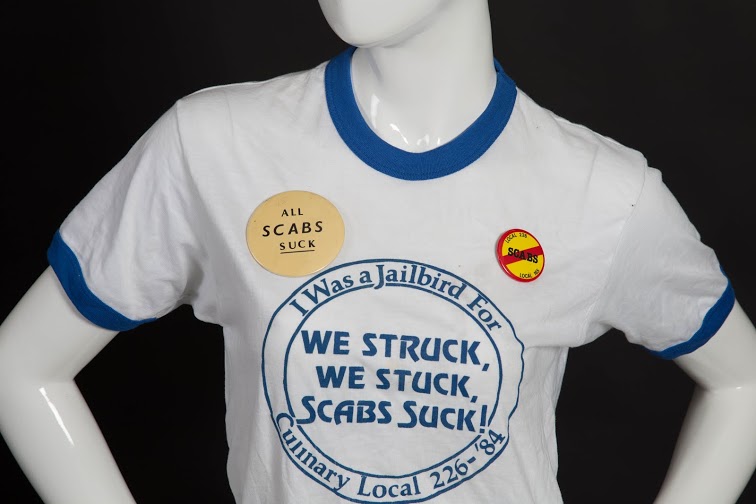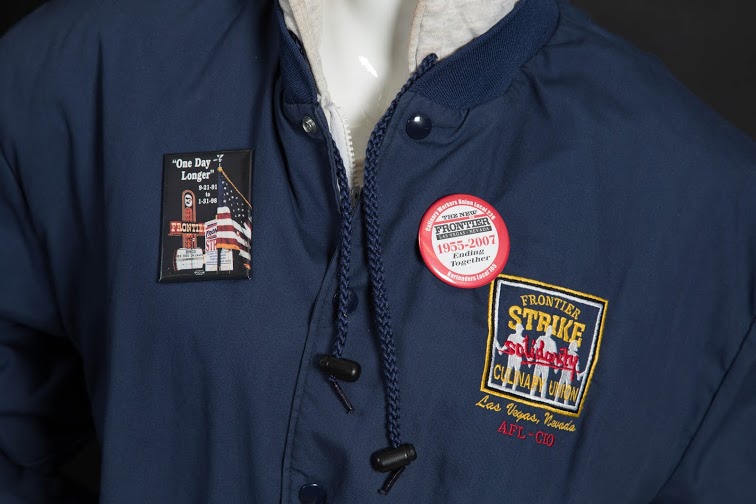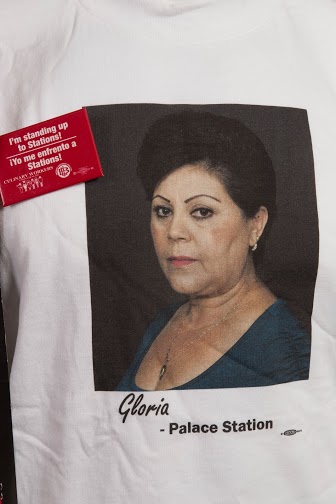FOR IMMEDIATE RELEASE
November 17, 2014
CONTACTS:
Franklin Howard (UNLV)
(330) 523-8947
Bethany Khan (The Culinary Union)
(702) 387-7088
UNLV’s Public History Program and University Libraries Bring Culinary Union History to the Community
LAS VEGAS, NV - The graduate students of the Public History Program at the University of Nevada, Las Vegas, and the UNLV University Libraries have teamed up to present an exhibit that captures the important history of one of the nation’s most recognizable unions, the Culinary Workers Union, Local 226, the largest local of UNITE HERE. “Line in the Sand: The People, Power, and Progress of the Culinary Union” is open to the public and will be on display from Dec. 5, 2014, through April 1, 2015, on the first floor of UNLV’s Lied Library.
This exhibit is the product of growing partnership that was forged between the Culinary Union and UNLV two years ago. Last spring, the Culinary Union invited students of UNLV’s Public History Program, under the guidance of Dr. Deirdre Clemente, to explore its storage sheds and closets to learn more about the largest union in Nevada. There, students discovered hidden treasures - various display objects such as banners, buttons, t-shirts, picket signs, photographs, and personal memorabilia just waiting to be curated and shared with the public for the first time.
The objects, however, represent only part of the Culinary Union’s rich history of nearly 80 years. The exhibit would continue to take shape as the stories of union members were gathered by students under the tutelage of UNLV Libraries’ Oral History Research Center (OHRC) Director Claytee White and facilitated by Bethany Khan, Director of Digital Strategy for the Culinary Union.
Oral histories containing stories from the 1960s to present day breathe additional life into the objects displayed behind the glass and provide insight into the experiences of those who have been part of the Culinary Union and Las Vegas’ world famous hospitality industry. Sound bites from union members and leaders will be available through QR codes that can be activated by visitors’ smartphones as they walk through the exhibit, adding another dimension to the experience of “Line in the Sand.”
UNLV celebrates the innovative collaboration with the Culinary Union that has enabled the history of Nevada’s largest labor organization to be shared with the greater Southern Nevada community through this dynamic exhibit.
“Central to the mission of the UNLV Libraries is to collect materials and oral histories that document Southern Nevada,” said Patricia Iannuzzi, Dean of the UNLV University Libraries. “The story of this region cannot be told without the voices and materials of its workers. UNLV Libraries and our Oral History Research Center are proud to help facilitate this wonderful student-led project.”
The exhibit will also highlight the Culinary Academy of Las Vegas, an internationally recognized model for labor-management cooperation, workplace education and vocational training, and the Culinary Health Fund, which provides medical coverage for over 120,000 participants in Nevada
“Line in the Sand” is presented in cooperation with the Culinary Union, the Bartenders Union, UNLV University Libraries, the College of Liberal Arts, the Nevada State Museum, and the Las Vegas News Bureau.
For more information on the UNLV Public History Program, please visit: www.UNLVPublicHistory.com.
For additional information on the “Line in the Sand” exhibition, please visit: www.UNLVPublicHistory.com/Culinary.

Culinary Union members pinned “scab” buttons to their shirts in opposition to non-union workers hired by casinos during strikes. The t-shirt was worn by a "jailbird" during the 1984 strike, after many protesters were arrested during the pickets that year.

This Frontier Strike jacket is a commemorative piece in remembrance of one of the longest strike in US history. Fastened to the jacket are pins also remembering the journey the Culinary Union members and striker took during their 6 years, 4 months, and 10 days conflict with the New Frontier Casino.

This t-shirt was part of a campaign by the Culinary Union to support Station Casino employees to have the right to unionize. The series of shirts had different pictures of Station Casino employees. Attached to the t-shirt is a button, written in English and Spanish, showing the Union's support of giving Station employees the right to choose.
###
